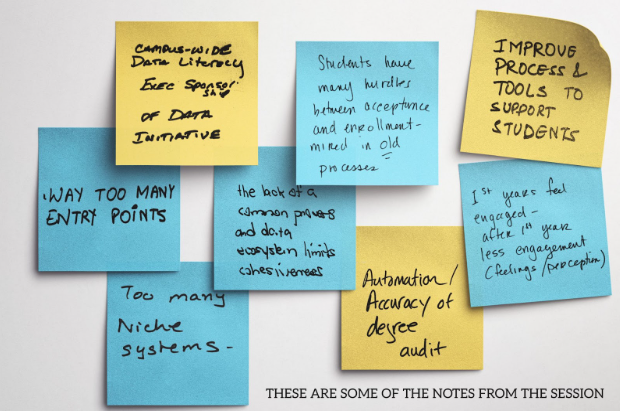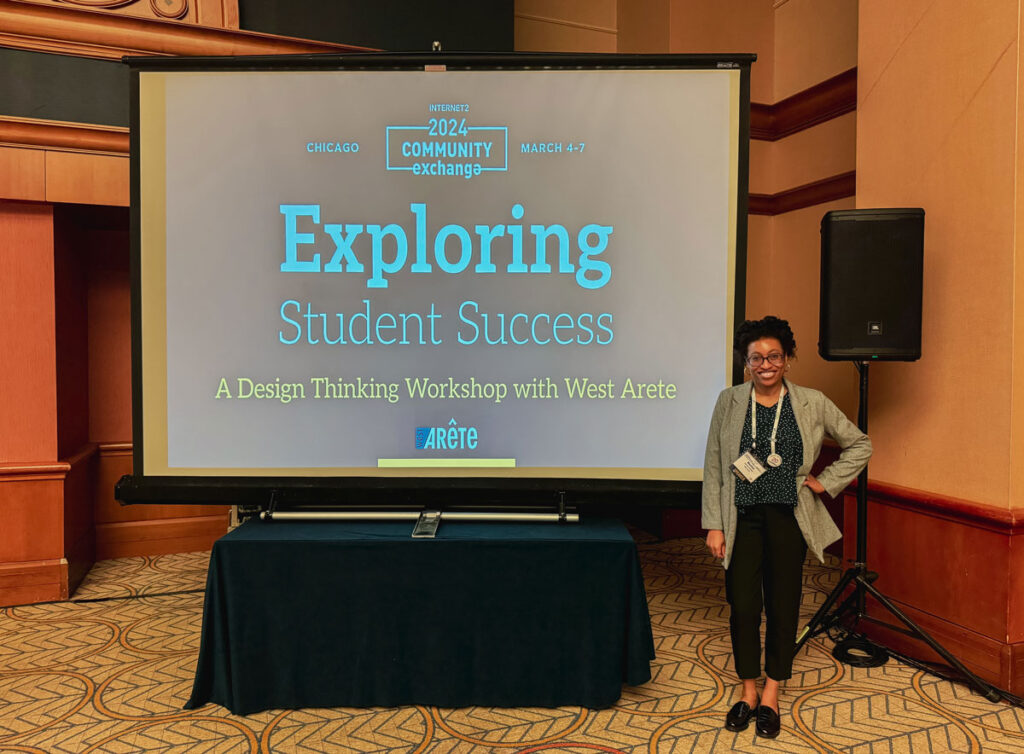Estimated reading time: 8 minutes
By Amber Rasche – Senior Communications Specialist, Internet2
During the 2024 Internet2 Community Exchange, participants in the Embracing New Tech for Student Success workshop applied a human-centered design framework in a set of exercises to align the student journey with the current technological and academic landscape. The workshop – led by Netta Caligari of West Arete, an InCommon Catalyst – put students at the center of the conversation. It offered new design-thinking methods and tools to help IT leaders think strategically about implementing innovative tech solutions to empower students to do their best work.
In this Q&A, Caligari sheds light on the human-centered design process — how it works and why it matters. She reflects on community conversations that took place during the workshop, including the big picture surrounding the most pressing challenges and the bottom line on outcomes. She also summarizes the takeaways that community IT leaders might apply at their own institutions to enhance the student experience in an era of digital transformation.

Tell us about the human-centered design framework used during the Embracing New Tech for Student Success workshop at CommEX24. How does this approach work, and why is it essential when integrating new technologies into the academic landscape?
When faced with a challenge, it’s human nature to want to jump in and solve it immediately. However, spending time first understanding the problems can be invaluable when it comes to making sure we’re solving critical challenges in meaningful ways.
This is why human-centered design thinking is so incredibly important, especially when embracing new technologies in an academic setting.

“Human-centered design thinking is an approach that focuses on understanding and solving problems by prioritizing the needs, perspectives, and experiences of the people involved. The methodologies within that framework involve empathy, ideation, and iteration to help develop solutions that genuinely address users’ pain points.”
My session at Community Exchange focused on the student experience, but this approach can also be applied to the tech needs of your administration, faculty, etc.
Workshop attendees participated in activities aimed at building compassion for students’ interactions with technology in higher education. We began with the Student Journey Map to identify challenges and opportunities in students’ academic technology use, followed by Priority Grouping to highlight key issues for focus. Participants then developed actionable solutions for these priorities, fostering collaborative insight through an Idea Chain exercise.

The audience definitely felt the fast pace of moving through all of the exercises in a 50-minute timeframe — and understandably so with the depth of content! The three exercises from the session typically take much longer to work through. But my main goal was to introduce the concepts and give participants a glimpse of how these methodologies work together. This introduction to design thinking highlighted the importance of exploring problems before leaping to solutions, directing efforts toward genuinely impactful outcomes.
Could you share some observations about the community conversations that took place during the workshop? What were the most salient challenges identified and themes identified?
Even though attendees were asked to represent their respective institutions, there was a lot of discussion and head-nodding happening among the tables. This really emphasized the commonalities people face regarding tech-related challenges and opportunities for the student experience. Thoughts posted to the Student Journey Map highlighted specific hurdles, such as navigating application processes and understanding degree requirements. They also keyed into the potential for artificial intelligence and improved online resources to simplify these processes. And when identifying areas of focus through Priority Grouping, key challenges identified included fragmented student experiences across platforms, data quality issues, and confusion about academic pathways.

When thinking about what steps they might take to address important difficulties they are facing with technology, attendees expressed strong agreement around needing to create a unified experience for students through enhancing data governance to support strategic decisions. The findings I captured emphasize the benefits of aligning institutional efforts with a clear focus on student needs in order to be really prepared for solutions, such as AI assistance. Overall, there was a collective determination to enhance the student experience through a thoughtful application of technology, paired with stronger data insights.
How does this translate to the major outcomes of the workshop, and what implications do the outcomes have for future campus IT initiatives?
The workshop results showcased that the core of technology challenges often stems from human problems and complexities.

“The future success of IT initiatives on campuses hinges on their capacity to bring diverse groups together, particularly those for whom the solution is intended. Technology challenges, as well as the opportunities they present, cannot be siloed from the human experiences they aim to enhance or streamline.”
Reflecting on the outcomes, it’s clear that future campus IT initiatives must prioritize creating spaces that break down silos across different departments and stakeholder groups. A collaborative approach — rooted in human-centered design thinking — can be pivotal for developing technology solutions that are deeply aligned with the real needs of people who are part of the campus community. I urge campus IT leaders to rethink how they can enhance the entire student journey through technology. This makes higher education more engaging, accessible, and efficient. And again, these principles can extend beyond students.

From your perspective, what key takeaways from the workshop should higher education IT leaders consider when enhancing the student experience in the digital age? How can these takeaways be practically applied in various institutional settings?
A crucial takeaway is the role of data in enhancing the student experience. The discussions around data quality and governance indicate that accurate, accessible, and actionable data is foundational for supporting decision-making and personalized student support. Higher education leaders must champion initiatives that aim to improve data quality, integrate disparate systems, and leverage analytics for insights into student needs and behaviors. This also implies a shift towards a more inclusive decision-making process, where feedback from students and frontline staff is actively sought and valued in shaping digital strategies.
Higher education needs a layered approach to digital transformation. IT leadership would benefit from strategies that encompass the full student journey. This includes prioritizing data integrity and literacy and cultivating an organizational culture that values collaboration and empathy. Regardless of your institution, these principles can help IT initiatives meet current demands while anticipating the needs of future student generations.
What strategies or approaches do you recommend for IT leaders to strategically implement new technologies while ensuring they remain human-centered?
Human-centered design revolves around a deep understanding of the people you’re aiming to help—be it students, faculty, and/or administration within your institution. Here are some starter steps for IT leaders aiming to effectively embrace new tech:
- Empathize with your end users. Start by deeply understanding the needs, challenges, and experiences of all users impacted by the technology. Conduct interviews, surveys, or focus groups to gather information. This is your foundation for developing solutions that genuinely address user pain points.
- Map your stakeholders. Early in your process, identify everyone who will need to make decisions around the technology in question. This helps anticipate potential objections or concerns by hearing from important voices throughout the project lifecycle. We want to prevent last-minute surprises that could derail your initiative.
- Clarify your ‘why.’ Clearly articulate the rationale behind the new technology implementation. This message should match the expectations and needs of all stakeholders. Misalignment here can lead to resistance or lack of support for the project.
For a more detailed exploration of actionable steps, as well as a deeper synthesis of the workshop, I’ve put together a detailed report for the workshop. This is all thanks to the valuable contributions from everyone who joined the session! That was the basis for creating this valuable resource as a way to understand varied experiences across different institutions.
Wrapping up, I want to extend my gratitude to Internet2 for letting us contribute our design thinking methodologies at Community Exchange. I hope everyone finds something useful to take back to their institution. Design thinking is at the heart of how we tackle complex challenges at West Arete, and sharing this approach with the participants was a highlight for me.
I really appreciate being part of such a wonderful community, and I look forward to sharing more about human-centered design in the future.

